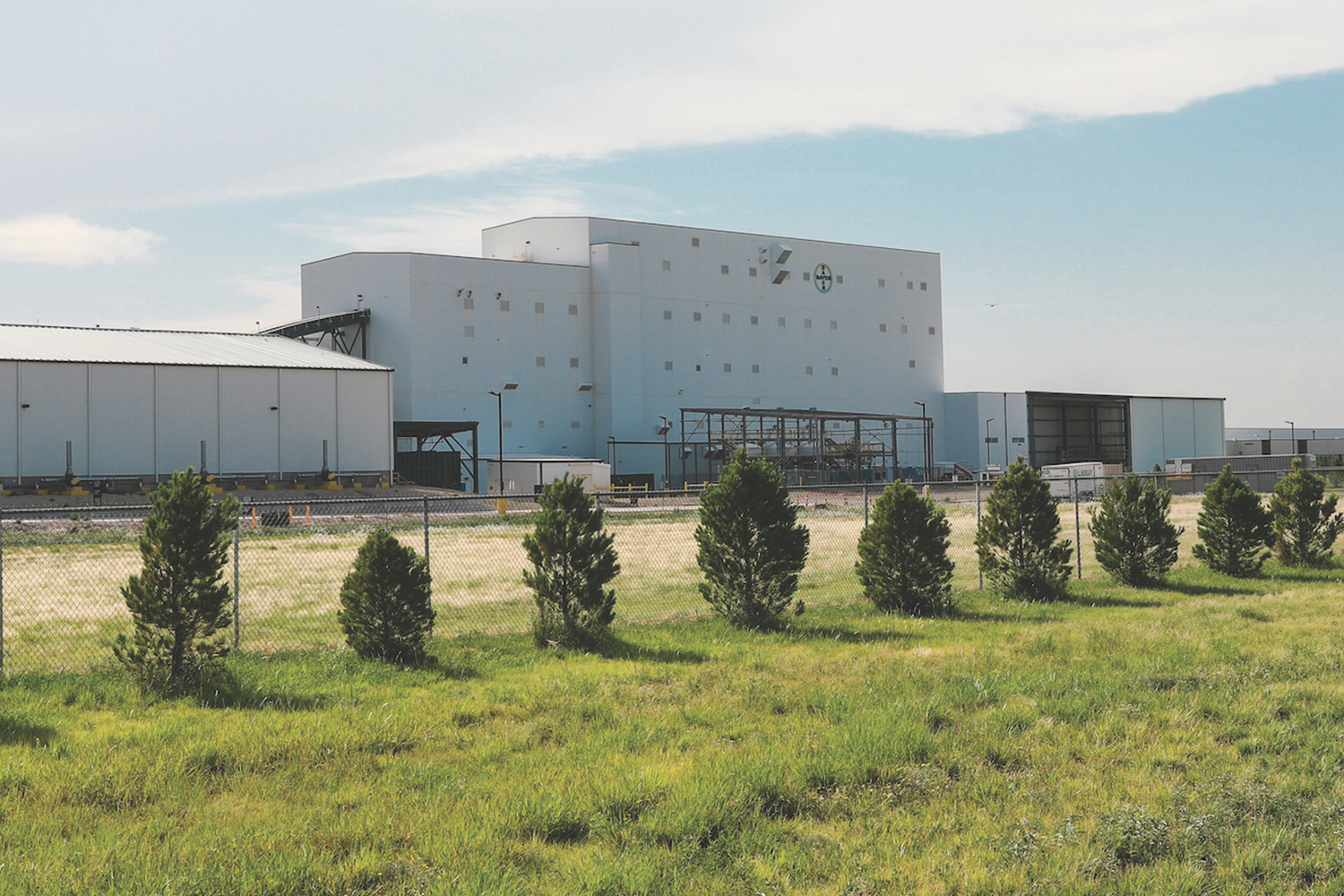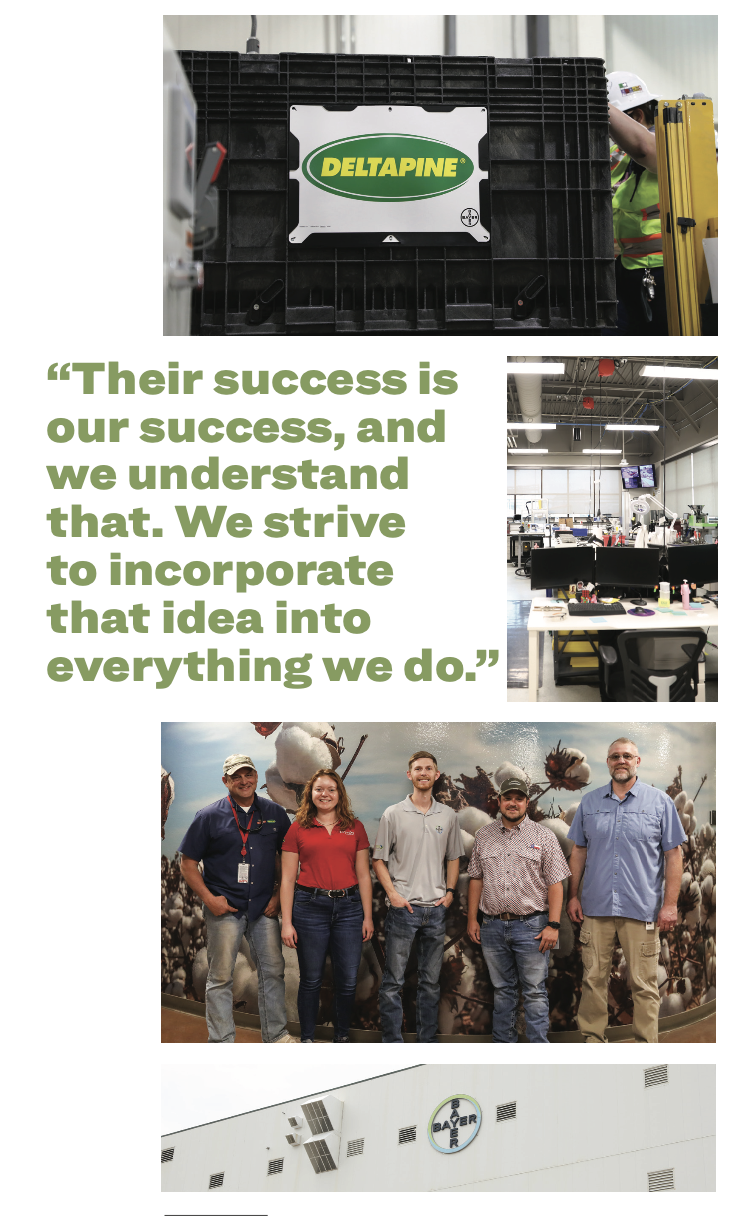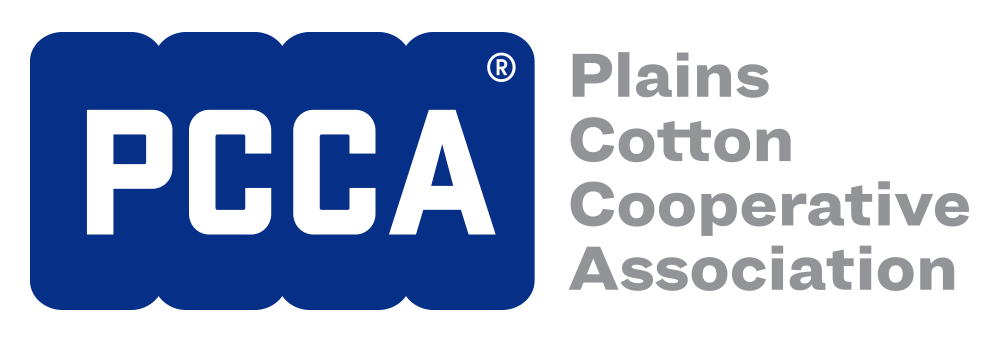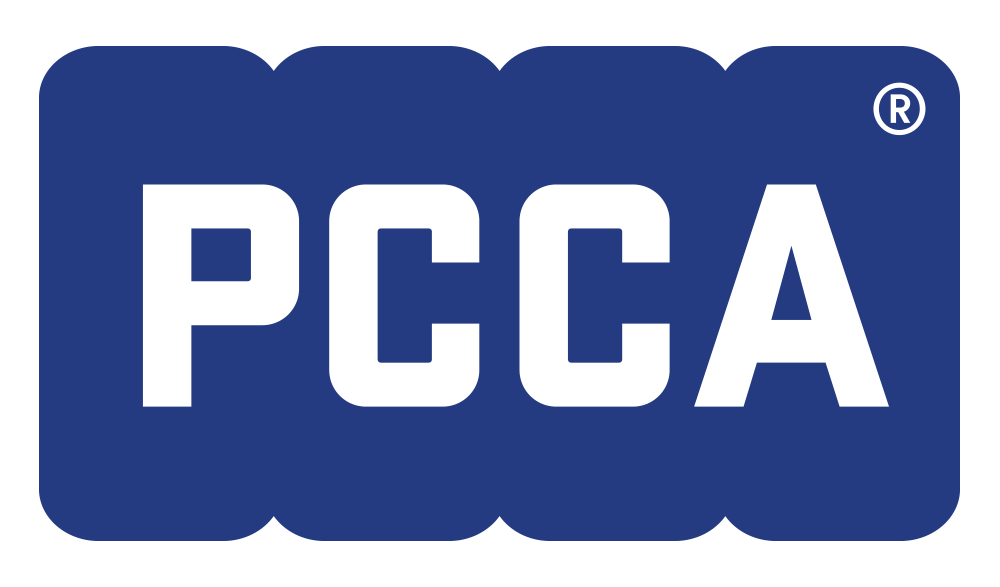 By Blair White | Photos by Jordan Albus
By Blair White | Photos by Jordan Albus
Travelers along the northern stretch of Interstate 27 just outside of Lubbock, Texas, can spot two landmarks that reflect the backbone of small, agriculture-based communities in West Texas: a high school football stadium that fills with fans each fall Friday night, and a cotton seed processing plant that underscores the region’s deep ties to the cotton industry.
Constructed from 2017 to 2018 in the heart of cotton country, Bayer’s Deltapine Cottonseed Manufacturing Site processes about half of the seed planted in the nation. A task of that size requires massive space – 500,000 square feet on 150 acres, to be exact. The $140 million site is the company’s hub for cottonseed production in the U.S.
“We operate in a hub and spoke model, and we service the entire U.S. Cotton Belt,” explained Jason Wildman, Bayer Lubbock’s Cotton Business Unit Lead for Manufacturing. “We have operations across the Cotton Belt, from growing and producing the seed in the field to getting that fuzzy seed to storage sites. Eventually, it all makes its way here to Lubbock to finish processing, treating, packaging, and distribution to a network of third-party warehouses and distribution centers on its way to the final customer.”
Turning out top-of-the-line seed doesn’t just happen overnight. It all starts with receiving fuzzy seed from gins across the region and quality control testing every step of the way.
Receiving
Even before the fuzzy seed arrives at the plant, the Bayer Lubbock team receives seed samples from modules or standalone plants in growers’ fields. At this stage, testing for various seed conditions and factors is essential. After the modules are processed at the gin and the seed reaches the processing plant, the entire truckload is tested again for purity conditions and to confirm the load of seed has the intended trait package.
“Every single truck has a trait test pulled on it,” said George Clements, Quality and Testing Control Lead. “We have a method of doing that test in about 30 minutes in our lab, so we can turn those trucks around quickly and decide whether to accept the load. It all starts at the module, but throughout the entire process, there’s a battery of tests happening.”
The specific tests carried out on a load of fuzzy seed include using X-ray to determine factors like maturity, damage, & seed size, a moisture test and a free fatty acid test of the seed oil. Through this process samples for a later warm germination test and a cool test are also pulled. Once the load of seed is accepted, it is stored in the seed house and continually monitored.
“We pull samples off that seed pile at regular intervals, and we’re usually doing more germination and cool tests to build a trend to see how dormancy is breaking for all those new crop batches each season,” Clements said. “Each has its own story and personality. We are building trends that help our planning organization, that help the product management team, that help the site schedulers understand when that seed will be ready to send through the de-linting and conditioning process.”
De-linting and Conditioning
When it’s time to process the seed, it’s loaded and trucked from the seed house to the production site to be cleaned and conditioned. “Once we’re ready to process that seed, we will truck it back to the site,” said Landon McLellan, Production Lead. “We will feed it into our system, where it will go through the de-linting process first. We use sulfuric acid to de-lint the seed, then send it through our conditioning process, where we clean it up and ensure that we’re getting to that pure black seed.”
After the black seed stage is achieved, the product will be cleaned again to remove any lingering field matter.
“After it’s de-linted and we’ve achieved the black seed stage, it will go through a cleaner, gravity table, and a color sorter,” explained Collin Connor, Bulk Operations Unit Lead. “That will remove any field trash and any seeds with visual damage.”
Additional tests are then conducted to examine the seed’s pH. The proper acidity level can help extend the seed’s life. Even while the cottonseed is stored in on-site bins, it’s tested at regular intervals to build data trends. This allows the team to have complete confidence that when the seed heads over to treating and packaging, the result will be a quality product that upholds Deltapine standards.
“After all of that testing, we’ve got this view of all the different time points for this batch of seed that come together and tell a story that can help us have confidence in what we’re releasing and help our customers have confidence in what they’re buying,” Clements said.
The Road to Commercialization
Before the finished seed product is commercialized, years of plot testing and perfecting are implemented to ensure the plant grown from the seed meets performance standards.
“We have different stages of product testing, what we call P2, P3, P4, then NPE, which is like pre-commercialization,” said Eric Best, Deltapine Cotton Product Manager. “The breeding groups at the P2 and P3 stages might be looking at hundreds of genetic lines from hundreds of varieties across some small test plots and different environments from California to the Carolinas.”
The breeding team will pick the top-performing lines from those plots and environments before the seed heads to P4 testing. This stage examines 15-18 varieties across the Cotton Belt’s varying geographic regions. In this part of the process, the technology development group conducts trials in a wider variety of environments with fewer products, but on a larger scale.
“So, instead of two rows by 40 feet, these plots might be eight rows by 150 feet, or a quarter of an acre in some cases,” explained Best. “These scientists are looking at things from germplasm to new traits and new technologies to native traits. They address all sorts of concerns, disease resistance, and anything specific to their respective environments. They’re responsible for breeding products and selecting products for those environments.”
A few years before commercialization, typically during the P3 to P4 stage, the commercial product development team begins to gain insight into the market segment, value, and size of the new cottonseed variety. After again selecting the cream of the crop, the variety will enter the New Product Evaluator System. In this system, seeds will be provided to approximately 220 NPE growers in various regions across the Cotton Belt to plant in 10- to 15-acre blocks and will be continually tested.
“They’ll grow enough so they can harvest it. It will be kept separate at the field and gin levels, and then we will receive feedback under their real-world conditions,” Best said. “Out of those varieties being tested, we might pick one or two, we might pick four or five. That’s how a product becomes commercial. If you’re familiar with the Deltapine naming system, the first two digits of the variety are the year it was commercially released. So, if you look at something from this past year, it has a 25 at the beginning. Those products were probably in testing programs beginning in 2017 and 2018 and were whittled down from hundreds of genetic lines to four or five.”
The cotton industry’s ever-changing nature calls for constant innovation on the part of the Bayer Lubbock team. Twenty years ago, the average lifespan of a seed variety on the market was seven to eight years; today, it is only three to four selling seasons.
“Not only is that a testament to growers wanting to be more progressive, but it’s also a testament to the fact that they know something better will be coming along,” said Best. “It’s not just in germplasm, but in biotech traits, native traits, or applications like the Bollguard Xtendflex, a new herbicide, or treatments to protect the plant from boll-worms, pests, or thrips across the belt; they’re always asking what’s next. We’re always looking at the next thing growers will need and asking how we can bring more value to them.”
Environmental and Economic Impact
The Bayer team is very conscious of sustainability factors, from adequately handling the byproducts of the production process to the number of people employed at the plant.
“This facility was designed and built for sustainability, said Wildman. “Proprietary technology and innovation went into creating this plant, not only to protect the quality of the seed but to ensure that our operations are as efficient as possible. We have a constant data stream to analyze and continuously optimize our processes. For example, we have meters on every process to know how much energy we consume, which can be filtered down to each process.”
Integration with the feed supply chain is key and directly impacts sustainability. For example, fuzzy or black seed that does not make it through to treatment is sent to local feed yards and dairies to be used in cattle feed. If the seed has been treated but needs to be eliminated further down the line, it is sent to a proper waste handling facility for disposal.
Ultimately, delivering the best-quality seed to the producers requires the collaboration of multiple experts in various roles. At the height of the season, the plant employs about 150 people from various disciplines, including mechanical and electrical engineers, reliability and integrity roles, asset care, maintenance, production, operators, quality management and quality testing, safety, logistics, and more. The average yearly economic impact of the facility is $10 million, making it a critical part of the High Plains’ cotton economy.
Planting Seeds for the Future
The Bayer Lubbock Team’s mission is to be the most trusted and innovative cottonseed supplier. Their cottonseed is bred, tested, and made for West Texas and other similar regions.
“That ties to Bayer’s broader mission in that we know our purpose is to deliver innovation to farmers to help them produce more, and at the same time, conserve more,” said Wildman. We know that farmers work tirelessly and navigate obstacles and challenges every year to produce cotton or whatever crop it may be, so we work tirelessly to innovate and bring new solutions and technologies to help with that. We also work to protect the quality of the seed and ensure that when they receive the product from us, it is something they can trust is going to perform.”
This commitment to innovation and quality extends beyond products and into the company’s relationship with growers across the Cotton Belt. At the heart of it all is a shared goal: to support growers with seed and a partnership built on trust and mutual success.
“Their success is our success, and we understand that,” said Best. “We strive to incorporate that idea into everything we do.”
From fuzzy seed brought in on 18-wheelers to the finished product finding its way to planter boxes across the Cotton Belt, Bayer’s Deltapine Cottonseed Manufacturing Site plays a vital role in keeping the cotton supply chain moving. In a place where agriculture shapes both identity and income, the facility continues to be an essential engine of economic activity.


